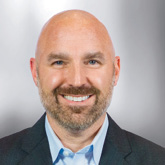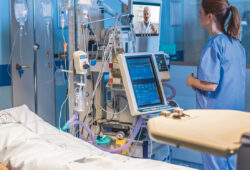
CPXP
While a lot has changed in hospitals since COVID-19, the fundamentals of a quality patient experience haven’t changed at all, according to Jason Wolf, Ph.D., CPXP, President of The Beryl Institute, a global community of practice dedicated to improving the patient experience through collaboration and shared knowledge. In fact, these fundamentals have only been elevated by what we’ve learned throughout the pandemic.
“The power of human connection has been realized to a much greater extent,” says Wolf.
The value of togetherness
COVID-19 has forced us to create space—space between patients, families and healthcare workers. For many, the results are feelings of isolation and burnout.
As hospitalized patients have had severe restrictions when it comes to visitors, staff have found new ways to fill the gaps in human connection. “They are not only holding the hand of a patient as they die, but they’re also holding the phone or iPad in front of them for the family member on the other end,” says Wolf.
An added challenge is that without the patients’ loved ones there to provide important information about the patient, there are barriers to giving care. This environment puts healthcare professionals under an incredible amount of pressure, so it’s no surprise that many feel some level of exhaustion.
“All of this has elevated the importance of not just the patient and family experience, but also the experience of all those who show up every day to provide care,” says Wolf.
Pausing data collection
As the pandemic caused hospital surges in many areas of the United States, it instantly changed a number of aspects of patient care, skewing data benchmarks. To account for this, and to help free up clinicians from paperwork so they could place all of their focus on caring for patients, the Centers for Medicare & Medicaid Services (CMS) waived many reporting requirements for Medicare quality data.
The Hospital Inpatient Quality Reporting Program data, which includes the Hospital Consumer Assessment of Healthcare Providers and Systems (HCAHPS) survey data, a national survey of patients’ perspectives of hospital care, was made optional in the fourth quarter of 2019. It also removed data requirements for the first two quarters of 2020.
Attempting to use the data to compare hospitals and reimburse them would be challenging, at best. “It would be like playing baseball in a football stadium. The stats wouldn’t make any sense,” Wolf says.
Considering the quality of virtual care
Still, hospitals are paying attention to HCAHPS, which remains an important window into understanding what matters to patients. One thing we‘ve learned in 2020 is that healthcare innovation can move a lot faster than previously thought. We are finding new ways to connect with people through telehealth—the use of which has increased exponentially across the country.
“Healthcare organizations have realized that virtual visits provide a better experience for some patients because they don’t have to drive, wait in traffic, pay to park in a garage or sit in a waiting room,” says Wolf. He predicts that models of care will be challenged in a positive way because they will be consumer-driven.
Out of many, one shared experience
The future of optimal healthcare quality is viewing the care team as one that includes patients, families and providers. It’s important to consider the well-being of every member of the care team because they are interconnected. “We have to think about them as a whole. Otherwise, we are shortchanging the experience,” says Wolf.
As we continue to move through this COVID crisis, healthcare leaders will need to keep rethinking the field as patient expectations have changed, including how we connect with one another and how we create a more equal experience for all.
“It’s no longer the new normal,” says Wolf. “It’s the new existence.”
Share Email COVID-19, Patient Experience, Q1 2021, Telehealth





